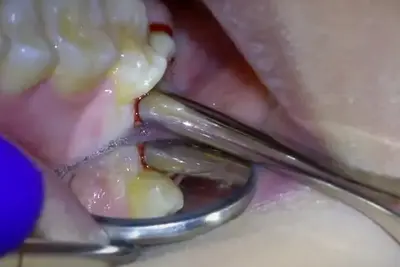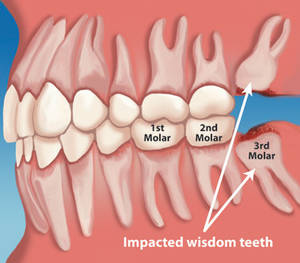There’s something unsettling about peeking into your mouth after wisdom tooth extraction and seeing white stuff where your tooth used to be. Is it a sign of healing, or something much worse? If you’ve found yourself wondering what exactly this mysterious white stuff is, you’re far from alone. Let’s break down the facts, explore some real medical perspectives, and offer you a clearer picture of what you might be dealing with.
The Common Causes of White Stuff
The white substance in a wisdom tooth socket is typically part of the healing process, but there are several possibilities for what it could be. Here’s a rundown of the most common explanations:
- Fibrin Clot: This is the most common explanation for the white stuff. Fibrin is a protein that plays a key role in blood clotting. After a tooth is removed, a blood clot forms to protect the socket. As it begins to heal, the clot transforms and takes on a whitish appearance, which is completely normal.
- Granulation Tissue: Over time, your body starts building granulation tissue in the extraction site. This tissue is essential for wound healing, containing new connective tissues and microscopic blood vessels. Its color can range from white to light pink, which often makes people worry that it’s an infection.
- Food Particles: Let’s not forget the less glamorous possibility—it could simply be food. The wisdom tooth sockets are essentially tiny pits in your gums, and it’s very easy for food to get trapped there.
- Pus: Less commonly, the white substance could indicate pus due to an infection. Infection often presents other symptoms, like a foul taste, swelling, and persistent pain. If you notice these symptoms, it’s time to see your dentist.
What Do the Stats Say?
Dry Socket—also known as alveolar osteitis—is one of the most dreaded complications of wisdom tooth extraction. Around 2-5% of people who have their wisdom teeth removed will develop a dry socket, characterized by an exposed bone where the clot has dislodged or dissolved too soon. Dry sockets can appear whitish due to exposed bone or dead tissue and are incredibly painful. Women taking oral contraceptives have a higher risk, as estrogen can interfere with the healing process.
Another relevant statistic is that nearly 85% of wisdom tooth extraction cases experience normal healing, where the white stuff is just part of the natural progression. Understanding these numbers can put your mind at ease—chances are, the white material is harmless.
Expert Opinions: Dentists Weigh In
Dr. Michael Adams, an oral surgeon with over 15 years of experience, says, “The white stuff is almost always a sign of the body’s natural healing process. It’s actually a great indicator that things are moving in the right direction. Granulation tissue is a sign that new connective tissue and blood vessels are forming to repair the wound.”
On the other hand, Dr. Linda Martinez, a general dentist, warns against complacency. “If the white stuff is accompanied by a foul smell, worsening pain, or swelling, it could mean an infection,” she notes. Dr. Martinez recommends getting in touch with your dentist if you notice any of these symptoms.
When to Relax and When to Call Your Dentist
The big question is, when should you worry? If the white stuff is painless and you don’t have other symptoms like fever, swollen lymph nodes, or a bad taste in your mouth, you’re likely in the clear. However, if your pain level is increasing, especially after the first two days, or you notice any other signs of infection, it’s time to act.
Pain can often be misleading. The majority of patients report that the first 48-72 hours are the toughest, but after that, discomfort generally starts to fade. If instead, the pain suddenly spikes after initially getting better, it could be a sign that the blood clot was lost—leading to a dry socket.
Practical Tips: Managing Your Healing Socket
- Keep It Clean (But Gently): Rinse your mouth with warm salt water after meals, starting 24 hours post-surgery. Avoid swishing aggressively, as this can dislodge the clot.
- Avoid Straws: Using straws can create negative pressure in your mouth, which may lead to the blood clot becoming dislodged. Stick to drinking directly from a cup.
- Soft Diet: Sticking to soft foods reduces the chance of food particles getting stuck in the socket. Mashed potatoes, scrambled eggs, and smoothies are your best friends for a few days.
- Pain Management: Over-the-counter pain relievers, such as ibuprofen, can help with discomfort. If the pain is severe or isn’t subsiding, contact your dentist.
The Lesser-Known Complications
Not every complication is dramatic, but they’re still worth noting. For instance, a small portion of people might develop osteomyelitis, a rare infection of the bone. Symptoms include severe pain, fever, and swelling, and it requires antibiotic treatment. The good news? This condition affects fewer than 1 in 1,000 people who undergo wisdom tooth extraction.
Another potential issue could be nerve damage, though it is very rare. If you notice numbness in your lips, chin, or tongue that persists beyond a few days, reach out to your healthcare provider.
Our Editorial Take
Seeing white stuff in your wisdom tooth socket is a common and, more often than not, completely normal part of the healing process. However, paying attention to your symptoms and trusting your instincts can help ensure that everything is on track. Don’t hesitate to call your dentist if something doesn’t feel right—whether it’s increased pain, a foul taste, or swelling. Healing doesn’t always look pretty, but the body is quite remarkable at repairing itself when given the right support.
Remember, proper aftercare is the key to a smooth recovery. Stick to soft foods, gentle rinsing, and keep an eye out for any unusual changes. And if you’re worried about what you see, always err on the side of caution and give your dentist a call. A little reassurance can go a long way when it comes to oral health.










what if that actually falls out because i play with it too much? is that dangerous?
“Don’t consume liquids without a straw”
You shouldn’t use straws at all! If you use a straw to drink, the blood clot likely will pop out and you’ll get dry socket…